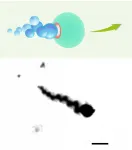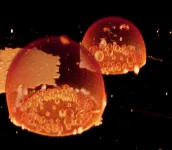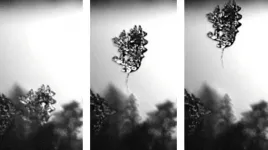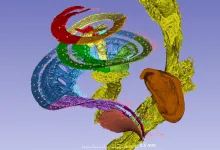(Press-News.org) For many, 2020 was notorious for the COVID-19 pandemic, but for climate scientists, the year is also infamous for tying with 2016 as the hottest since records began. 'Nine of the warmest years on record have occurred since 2010', says JEB Editor-in-Chief, Craig Franklin. With the ice caps and glaciers melting, devastating bushfires scorching arid regions, and hurricanes and typhoons battering coastal communities, the impact on local ecosystems has been catastrophic. 'Physiologists can play a critical role in the conversation around climate change', says Franklin, explaining that knowledge of physiology ideally positions comparative physiologists to predict the impact of climate change on species and to inform conservation policy and action.
Franklin and Hans Hoppeler (JEB Editor-in-Chief, 2004-2020) have commissioned a series of review articles dedicated to strategies for, and predictions of, the impact of climate change on ecosystems across the globe. The collection discusses our current understanding of the physiological impact of the climate crisis and the lessons that will inform biodiversity management and conservation in the coming decade.
Looking to the future, Franklin is optimistic. 'Physiologists and experimental biologists can make valuable contributions to our understanding of threats to biodiversity', he says, adding that comparative physiologists can clearly make pivotal contributions to the dialogue surrounding conservation. Understanding the interactions between animals and their environments and how those will change as temperatures rise, climate patterns change and population distributions shift, is essential for building policies to protect keystone and vulnerable species alike. From Diamond and Martin's review detailing the lessons that we can learn from urban heat islands to Putnam's optimism for the future of corals, this collection of reviews provides a foundation for comparative physiologists to build on as the vanguard in the battle to protect biodiversity. 'We see this as an important special issue. We know we are imperilled by climate change, but this collection of articles talks about what we should be doing in the future to protect the planet', says Franklin.
INFORMATION:
The collection includes the flowing articles:
Strategies for predicting the future:
Climate impacts on organisms, ecosystems and human societies: integrating OCLTT into a wider context, by Pörtner, H.O. J. Exp. Biol. 224, jeb238360. Doi: 10.1242/jeb.238360.
Physiological adaptation to cities as a proxy to forecast global-scale responses to climate change, by Diamond, S.E. and Martin, R.A. J. Exp. Biol. 224, jeb229336. Doi: 10.1242/jeb.229336.
Towards more integration of physiology, dispersal and land-use change to understand species responses to climate change, by Hof, C. J. Exp. Biol. 224, jeb238352. Doi: 10.1242/jeb.238352.
Prediction case studies: reptiles:
Predicting the effects of climate change on incubation in reptiles: methodological advances and new directions, by Carter, A.L. and Janzen, F.J. J. Exp. Biol. 224, jeb236018. Doi: 10.1242/jeb.236018.
Diving in hot water: a meta-analytic review of how diving vertebrate ectotherms will fare in a warmer world, by Rodgers, E.M., Franklin, C.E. and Noble, D.W.A. J. Exp. Biol. 224, jeb228213. Doi: 10.1242/jeb.228213.
Prediction case studies: mammals
How dryland mammals will respond to climate change: the effects of body size, heat load, and a lack of food and water, by Fuller, A., Mitchell, D., Maloney, S.K., Hetem, R.S., Fonseca, V.F.C., Meyer, L.C.R., van de Ven, T.M.F.N. and Snelling, E.P. J. Exp. Biol. 224, jeb238113. Doi: 10.1242/jeb.238113.
Physiological consequences of Arctic sea ice loss on large marine carnivores: unique responses by polar bears and narwhals, by Pagano, A.M. and Williams, T.M. (2021). J. Exp. Biol. 224, jeb228049. Doi: 10.1242/jeb.228049.
Prediction case study: birds
Thermoregulation in desert birds: scaling and phylogenetic variation in heat tolerance and evaporative cooling, by McKechnie, A.E., Gerson, A.R. and Wolf, B.O. J. Exp. Biol. 224, jeb229211. Doi: 10.1242/jeb.229211.
Prediction case studies: insects
Dealing with predictable and unpredictable temperatures in a climate change context: the case of parasitoids and their hosts, by Le Lann, C., van Baaren, J. and Visser, B. J. Exp. Biol. 224, jeb238626. Doi: 10.1242/jeb.238626.
Shifts in the relative fitness contributions of fecundity and survival in variable and changing environments, by Buckley, L.B., Schoville, S.D. and Williams, C.M. J. Exp. Biol. 224, jeb228031. Doi: 10.1242/jeb.228031.
Prediction case study: aquatic species
The role of mechanistic physiology in investigating impacts of global warming on fishes, by Lefevre, S., Wang, T. and McKenzie, D.J. J. Exp. Biol. 224, jeb238840. Doi: 10.1242/jeb.238840.
Bioenergetics in environmental adaptation and stress tolerance of aquatic ectotherms: linking physiology and ecology in a multistressor landscape, by Sokolova, I. J. Exp. Biol. 224, jeb236802. Doi: 10.1242/jeb.236802.
Avenues of reef-building coral acclimatization in response to rapid environmental change, by Putnam, H.M. J. Exp. Biol. 224, jeb239319. Doi: 10.1242/jeb.239319.
IF REPORTING THIS STORY, PLEASE MENTION JOURNAL OF EXPERIMENTAL BIOLOGY AS THE SOURCE
This article is posted on this site to give advance access to other authorised media who may wish to report on this story. Full attribution is required, and if reporting online a link to jeb.biologists.com is also required. The story posted here is COPYRIGHTED. Therefore advance permission is required before any and every reproduction of each article in full. PLEASE CONTACT permissions@biologists.com
THIS ARTICLE IS EMBARGOED UNTIL WEDNESDAY, 24 FEBRUARY 2021, 8:00 HRS EST (13:00 HRS GMT)
As part of the Journal of Experimental Biology's Special Issue dedicated to climate change, Anthony Pagano (San Diego Zoo Global, USA) and Terrie Williams (University of California, Santa Cruz, USA), discuss the impact of environmental change on two iconic polar species; the polar bear and narwhal. Their review article is published in Journal of Experimental Biology at https://jeb.biologists.org/content/224/Suppl_1.
Mammals in the Polar Regions face an uncertain future as unprecedented warming drives catastrophic sea ice loss, driving polar bears onto land, after losing access to sea ice and ...
Rheumatoid arthritis is a chronic inflammatory disorder marked by joint pain, swelling and damage. Although medications, such as steroids, anti-inflammatory drugs and immunosuppressants, can help slow joint destruction and relieve pain, they have side effects and aren't completely successful. Now, researchers reporting in ACS' Nano Letters have developed magnesium-based micromotors propelled by hydrogen bubbles, which improved rheumatoid arthritis symptoms when injected into the joints of rats.
Scientists have linked rheumatoid arthritis development to the excess production of reactive oxygen species (ROS). ROS can oxidize and degrade cartilage and bone, as well as activate the expression of inflammatory cytokines. A new type of therapy, hydrogen gas, can neutralize ROS ...
To come into being, galaxies need a steady diet of cold gases to undergo gravitational collapse. The larger the galaxy, the more cold gas it needs to coalesce and to grow.
Massive galaxies found in the early universe needed a lot of cold gas--a store totaling as much as 100 billion times the mass of our sun.
But where did these early, super-sized galaxies get that much cold gas when they were hemmed in by hotter surroundings?
In a new study, astronomers led by the University of Iowa report direct, observational evidence of streams of cold gas they believe provisioned these early, massive galaxies. They detected cold gas pipelines that knifed through the hot atmosphere in the dark matter halo of an early massive galaxy, supplying the materials ...
New research by the University of Oslo provides evidence that the "protocells" that formed around 3.8 billion years ago, before bacteria and single-celled organisms, could have had specialized bubble-like compartments that formed spontaneously, encapsulated small molecules, and formed "daughter" protocells.
ROCKVILLE, MD - Scientists have long speculated about the features that our long-ago single-celled ancestors might have had, and the order in which those features came about. Bubble-like compartments are a hallmark of the superkingdom to which we, and many other species including yeast, belong. But the cells in today's superkingdom have a host of specialized molecules that help make and shape these bubbles inside our ...
ATLANTA - FEBRUARY 24, 2021 - New study reports that early in the 2020 pandemic in the United States, one-third of cancer survivors worried about treatment and cancer care disruptions. Using a mixed methods approach, investigators utilized survivors' own words to more deeply describe their experiences and worries about the pandemic's impact on their overall health.
The article, appearing in the Journal of Psychosocial Oncology, finds the impact of the pandemic on cancer survivors and the broader health care system is widespread and exacerbated serious gaps in the health care system. For this study, investigators led by Corinne Leach, MPH, MS, PhD, from the American ...
If you have ever gotten up on a winter morning and thrown yourself into the arduous task of scraping frost from a windshield, a Virginia Tech lab is engaging science [IS1] that could make your life much easier. In research funded by the National Science Foundation, Associate Professor END ...
DALLAS, Feb. 24, 2021 -- Postmenopausal women who ate high levels of plant protein had lower risks of premature death, cardiovascular disease and dementia-related death compared with women who ate less plant proteins, according to new research published today in the Journal of the American Heart Association, an open access journal of the American Heart Association.
Previous research has shown an association between diets high in red meat and cardiovascular disease risk, yet the data is sparse and inconclusive about specific types of proteins, the study authors ...
In the largest genome-wide association study of glaucoma comparing the genes of 34,179 people with the disease to 349,321 control subjects, an international consortium of researchers identified 44 new gene loci and confirmed 83 previously reported loci linked to glaucoma. Loci are considered "genetic street addresses," denoting a specific location on a gene.
The study's authors hope the identification of these genes will lead to new treatment targets for this incurable eye disease that is a leading cause of blindness worldwide.
"These new findings come out of the highest-powered genome-wide association study of glaucoma to date, and show the power of team science and using big data to answer questions when research groups around the world join forces," said co-senior study author ...
Peer review/Experimental study/Cells
Researchers at Uppsala University have created the first 3D map of the hearing nerve showing where the various sound frequencies are captured. Using what is known as synchrotron X-ray imaging, they were able to trace the fine nerve threads and the vibrating auditory organ, the cochlea, and find out exactly how the frequencies of incoming sound are distributed. The study is published in Scientific Reports.
"This can make treatment with cochlea implants for the hearing-impaired more effective," says Helge Rask-Andersen, Professor of Experimental Otology at Uppsala ...
Genome variation data on more than 7,000 malaria parasites from 28 endemic countries is released today (24 February) in Wellcome Open Research. It has been produced by MalariaGEN, a data-sharing network of groups around the world who are working together to build high-quality data resources for malaria research and disease control.
This open data release represents the world's largest resource of genomic data on malaria parasite evolution and drug resistance. It provides benchmark data on parasite genome variation that is needed in the search for new drugs and vaccines, and in the development of surveillance tools for malaria control and elimination.
Malaria is a major global ...




